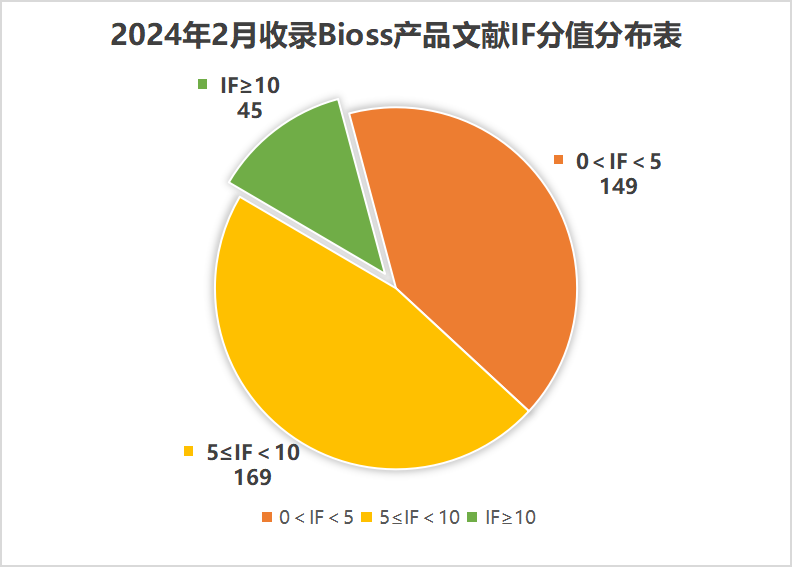截止目前,引用Bioss产品发表的文献共29281篇,总影响因子141751.15分,发表在Nature, Science, Cell以及Immunity等顶级期刊的文献共68篇,合作单位覆盖了清华、北大、复旦、华盛顿大学、麻省理工学院、东京大学以及纽约大学等国际知名研究机构上百所。
我们每月收集引用Bioss产品发表的文献。若您在当月已发表SCI文章,但未被我公司收集,请致电Bioss,我们将赠予现金鼓励,金额标准请参考“发文章 领奖金”活动页面。
近期收录2024年2月引用Bioss产品发表的文献共363篇(图一,绿色柱),文章影响因子(IF) 总和高达2298.3,其中,10分以上文献45篇(图二)。

图一

图二
本文主要分享引用Bioss产品发表文章至Nature, Immunity, Cancer Cell等期刊的5篇 IF>15 的文献摘要,让我们一起欣赏吧。
Molecular Cancer [IF=37.3]

文献引用产品:bsm-33070M
Ki-67 Mouse mA | IHC
作者单位:重庆医科大学
摘要:CircPDHK1 was upregulated in ccRCC tissues and closely related to WHO/ISUP stage, T stage, distant metastasis, VHL mutation and Ki-67 levels. CircPDHK1 had a functional internal ribosome entry site (IRES) and encoded a novel peptide PDHK1-241aa. Functionally, we confirmed that PDHK1-241aa and not the circPDHK1 promoted the proliferation, migration and invasion of ccRCC. Mechanistically, circPDHK1 was activated by HIF-2A at the transcriptional level. PDHK1-241aa was upregulated and interacted with PPP1CA, causing the relocation of PPP1CA to the nucleus. This thereby inhibited AKT dephosphorylation and activated the AKT-mTOR signaling pathway.
Cellular & Molecular Immunology [IF=24.1]

文献引用抗体:
bs-2789R; Tap1 Rabbit pAb | FC
bs-2374R; TAP2 Rabbit pAb | FC
作者单位:北京大学
摘要:CD4+ T cells can "help” or "license” conventional type 1 dendritic cells (cDC1s) to induce CD8+ cytotoxic T lymphocyte (CTL) anticancer responses, as proven in mouse models. We recently identified cDC1s with a transcriptomic imprint of CD4+ T-cell help, specifically in T-cell-infiltrated human cancers, and these cells were associated with a good prognosis and response to PD-1-targeting immunotherapy. Here, we delineate the mechanism of cDC1 licensing by CD4+ T cells in humans. Activated CD4+ T cells produce IFNβ via the STING pathway, which promotes MHC-I antigen (cross-)presentation by cDC1s and thereby improves their ability to induce CTL anticancer responses. In cooperation with CD40 ligand (L), IFNβ also optimizes the costimulatory and other functions of cDC1s required for CTL response induction. IFN-I-producing CD4+ T cells are present in diverse T-cell-infiltrated cancers and likely deliver “help” signals to CTLs locally, according to their transcriptomic profile and colocalization with “helped/licensed” cDCs and tumor-reactive CD8+ T cells. In agreement with this scenario, the presence of IFN-I-producing CD4+ T cells in the TME is associated with overall survival and the response to PD-1 checkpoint blockade in cancer patients.
ADVANCED FUNCTIONAL MATERIALS [IF=19.0]

文献引用产品:bs-4917R
Osteocalcin Rabbit pAb | IF
作者单位:北京大学口腔医院
摘要:Utilization of electro-responsive biomaterials with antibacterial properties is advantageous for facilitating septic wound healing and tissue regeneration. However, the dose-response effects of electrical stimuli from these materials against bacteria are not rigorously characterized, and achieving synergy of bactericidal and pro-regenerative effects of biomaterials remains a major challenge. Here, a graded series of flexible BaTiO3/P(VDF-TrFE) electroactive nanocomposite membranes (EMs) are developed with varying surface charge intensities, to serve as antibacterial dressing for septic wound healing. EMs display broad-spectrum antibacterial effects against both Gram-positive and Gram-negative bacteria in a dose-dependent manner, depending on the magnitude of their surface electrical potential. Mechanistically, the surface charge of EMs increase intracellular levels of reactive oxygen species within bacteria cells, which in turn caused oxidative damage to the bacterial membrane, thereby suppressing bacterial activity and biofilm formation. Moreover, in vivo studies demonstrated that EMs effectively inhibited S. aureus infection and accelerated wound healing in a mouse skin defect model, as well as ameliorated P. gingivalis-mediated periodontal inflammation in a mouse periodontitis model. Hence, this study optimizes the antibacterial properties of electroactive materials and characterizes the dose-response effects of surface electrical charge against bacteria, thus validating the therapeutic applications of electroactive biomaterials in combating bacterial infection.
ACS Nano [IF=17.1]

文献引用抗体:
bs-0292P; BSA-V
D-9106; DAPI
bsm-33070M; Ki-67 Mouse mAb | IF
作者单位:北京大学
摘要:Cancer progression and treatment-associated cellular stress impairs therapeutic outcome by inducing resistance. Endoplasmic reticulum (ER) stress is responsible for core events. Aberrant activation of stress sensors and their downstream components to disrupt homeostasis have emerged as vital regulators of tumor progression as well as response to cancer therapy. Here, an orchestrated nanophotoinducer (ERsNP) results in specific tumor ER-homing, induces hyperthermia and mounting oxidative stress associated reactive oxygen species (ROS), and provokes intense and lethal ER stress upon near-infrared laser irradiation. The strengthened “dying” of ER stress and ROS subsequently induce apoptosis for both primary and abscopal B16F10 and GL261 tumors, and promote damage-associated molecular patterns to evoke stress-dependent immunogenic cell death effects and release “self-antigens”. Thus, there is a cascade to activate maturation of dendritic cells, reprogram myeloid-derived suppressor cells to manipulate immunosuppression, and recruit cytotoxic T lymphocytes and effective antitumor response. The long-term protection against tumor recurrence is realized through cascaded combinatorial preoperative and postoperative photoimmunotherapy including the chemokine (C–C motif) receptor 2 antagonist, ERsNP upon laser irradiation, and an immune checkpoint inhibitor. The results highlight great promise of the orchestrated nanophotoinducer to exert potent immunogenic cell stress and death by reinforcing ER stress and oxidative stress to boost cancer photoimmunotherapy.
Advanced Science [IF=15.1]

文献引用抗体:
bs-0292P-FITC; BSA / FITC | IF
bsm-60235R; Keratin 6 Recombinant Rabbit mAb | IF
作者单位:南方医科大学
摘要:To address current challenges in effectively treating large skin defects caused by trauma in clinical medicine, the fabrication, and evaluation of a novel radially aligned nanofiber scaffold (RAS) with dual growth factor gradients is presented. These aligned nanofibers and the scaffold's spatial design provide many all-around “highways” for cell migration from the edge of the wound to the center area. Besides, the chemotaxis induced by two growth factor gradients further promotes cell migration. Incorporating epidermal growth factor (EGF) aids in the proliferation and differentiation of basal layer cells in the epidermis, augmenting the scaffold's ability to promote epidermal regeneration. Concurrently, the scaffold-bound vascular endothelial growth factor (VEGF) recruits vascular endothelial cells at the wound's center, resulting in angiogenesis and improving blood supply and nutrient delivery, which is critical for granulation tissue regeneration. The RAS+EGF+VEGF group demonstrates superior performance in wound immune regulation, wound closure, hair follicle regeneration, and ECM deposition and remodeling compared to other groups. This study highlights the promising potential of hierarchically assembled nanofiber scaffolds with dual growth factor gradients for wound repair and tissue regeneration applications.